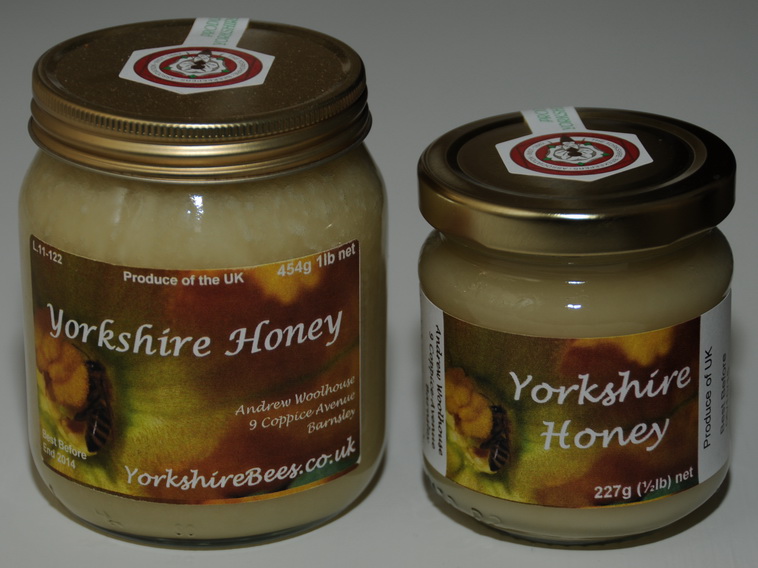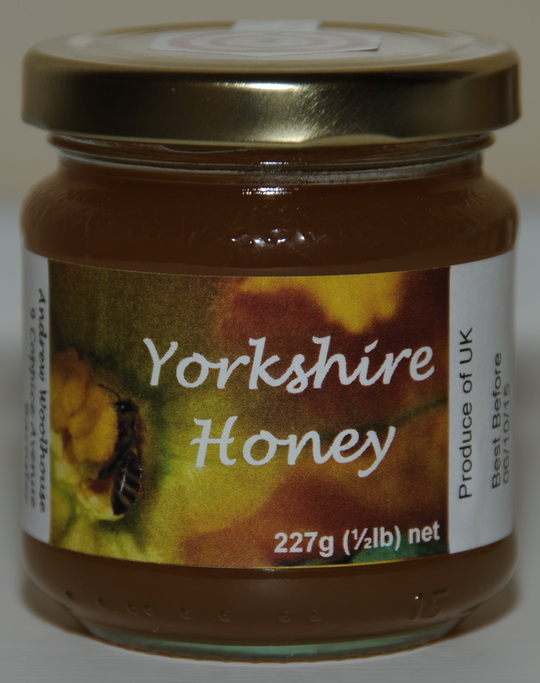Honey
Honey is made by bees from nectar collected from flowers. Honey bees transform nectar into honey and store it as a primary food source in wax honeycombs inside the beehive. beekeepers encourage overproduction of honey so the excess can be harvested from the colony.
Honey comes in an endless variety of colours and flavours that are influenced by the flowers that the bees collect the nectar from.
Honey from my Bees
Where to buy award winning honey from YorkshireBees
My honey is for sale locally in the following places
Choosys - Website (Spring / Summer Honey)
5 King Street, Huddersfield HD1 2QD
Also available direct from myself, contact me via e-mail to arrange a supply.
Currently my bees produce 2 different kinds of honey:-
Yorkshire Spring Honey (Soft Set / Spreadable) - Supreme Champion Countryside Live 2013
This has a high amount of nectar collected from early Spring flowers including Oil Seed Rape, Hawthorne, Apple blossom, Cherry, Horse chestnut and Dandelion. It's higher ratio of dextrose to levulose sugars causes it to crystallize and set solid. By adding a small amount of Summer honey to this and mixing we produce a 'soft set' honey that will be spreadable but not set hard for the duration of it's lifetime. Perfect on toast or sandwiches as it won't run off the bread!

*** This honey won the Supreme Champion award at the Countryside Live / YBKA Honey show 2013 ***
Yorkshire Summer Honey (Runny)
Made from the many flowering nectar sources available during the Summer months. Generally darker than Spring honey and remains in a fluid state longer. Most people have an image of runny honey when they think of honey.

Caring for your honey
All types of Honey, due to their high sugar content and low water content, do not require any special care for storage. Honey should be kept at room temperature and is quite happy being kept in a slightly cooler / dark and dry place such as a cupboard, it does not need to be kept in the fridge, even after opening. The only things that need to be avoided are dampness and high temperatures. Honey has a relatively low water content and will therefore absorb water from the surrounding air if the lid is left off too long.
Crystallization
Almost all honeys will form crystals (solids) in the jar eventually. This is a natural process and does not affect the taste or quality of the honey. The amount of time before honey crystallizes is generally determined by the different sugar ratios in the nectar that the bees made the honey from.
If and when a jar of honey starts to crystallize it can be returned to it's fluid form by gently warming it. The easiest way to do this is by placing the jar in a bowl of warm water and leaving it for some time. Honey does not transmit heat as fast as most liquids therefore the process to warm honey takes time and has to be done gradually.
High heat can harm honey and placing a jar in direct contact with high temperatures will degrade the honey. Under no circumstances would I recommend placing honey in a microwave oven!